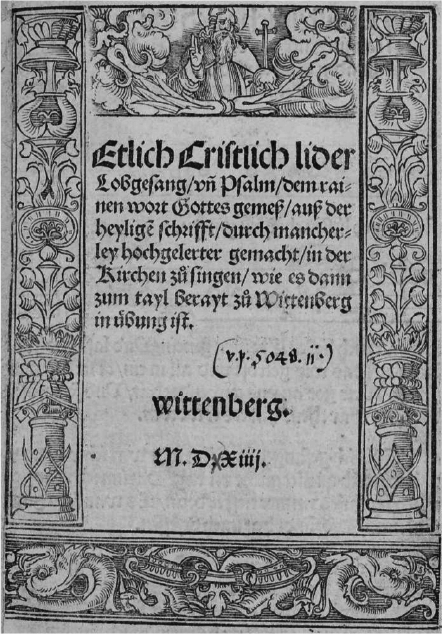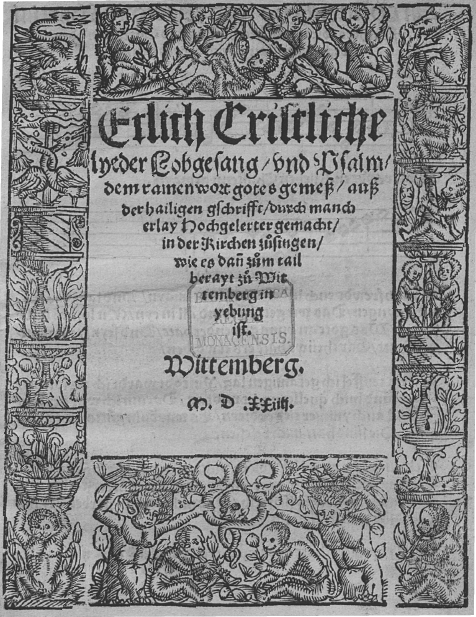Achtliederbuch Woodcuts
This year marks the 500th anniversary of the first Lutheran hymnal, the Achtliederbuch (the Eight Song Book). More a pamplet than a book, the Achtliederbuch contained eight hymns: four by Martin Luther, three by Paul Speratus, and one anonymous. The official title was much longer:
Etlich Cristliche lider Lobgesang / und Psalm / dem rainen wort Gottes gemeß / auß der heyligen schrifft durch mancherley hochgelerter gemacht / in der Kirchen zu singen / wie es dann um tayl berayt zu Wittenberg in übung ist.
Some Christian Hymns, Songs of Praise, and Psalms, According to the Pure Word of God from the Holy Scriptures, by Several Learned Authors, to be Sung in the Churches as Prepared and Practiced in Wittenberg.
To celebrate its anniversary and in conjunction with the Wisconsin Evangelical Lutheran Synod’s National Conference on Worship, Music, and the Arts, I made recreations of the original woodcuts found on the title pages of the first printings.
Variants
Most collections and literature on the Achtliederbuch point to three main variations, which differ in minute details.1 Sometimes this gets mistakenly described as three printings, but that is not the case. There is evidence of at least four, if not five or more printings in 1524. The following is an overview of those printings with some of their notable differences and corrections.
| variants | details |
|---|---|
| A1a | Woodcuts: Plates 124:1 (top), 120:1 (sides), 120:3 (bottom, upside down)2 |
| The date on the title page is incorrectly given as “1514” instead of “1524” | |
| Printed in Nuremberg, not Wittenberg, by Jobst Gutknecht. | |
| The date following the first hymn has an upside-down “3” in “1523. | |
| A1b | Most remains the same from the previous printing, other than small typographic fixes, such as the “3” in the date after the first hymn.3 |
| A2a | Title page has new top woodcut: 120:1 (upside down) |
| A2b | Most remains the same from the previous printing, other than the correct date on the title page (1524) and the date change after the first hymn (1524). |
| A3 | Different woodcut and title arrangement from previous printings. |
| Printed in Augsburg by Melchior Ramminger, despite “Wittemberg” given as the publication. | |
| Different typography and spellings used throughout to reflect the difference of dialects between the regions. | |
| Uses time signatures in the music notation. |
Woodcuts
All variants of the Achtliederbuch have a border on the title page. The woodcuts from the first four printings were made by Erhard Schön, a pupil of Albrecht Dürer. These use the same side and bottom panels. The bottom panel is flipped, likely through printing error.
The first two printings show a representation of Christ holding the globus cruciger in the top panel. The third and fourth printings use a floral woodcut, which is flipped. None of these woodcuts are unique to the Achtliederbuch. Title page woodcuts were often reused for various publications.4 What is perhaps the most unique about the woodcuts in the Achtliederbuch is the flipped orientation of the top and bottom panels in some of the printings. The fifth printing in Augsburg uses four different panels by an unknown artist.
For a limited time, I am offering my recreations of the woodcuts for free, which may be downloaded here. They include panels from the first and second variants, as well as select art from the Augsburg variant. More information about the Achtliederbuch may be found at the links below.
Copies of the Achtliederbuch:
https://www.deutsche-digitale-bibliothek.de
https://digital.staatsbibliothek-berlin.de
https://dia.pitts.emory.edu/image_details.cfm?ID=2525
-
Luther, Martin. Luthers Werke: Lieder, vol. 35. (Weimar: Weimar: Hermann Bohlaus Nachfolger, 1923), 336–337 ↩
-
Luther, Johannes. Die Titeleinfassungen der Reformationszeit, vol. 3. 1909-13. Retrieved from the Digital Public Library of America, http://catalog.hathitrust.org/Record/100005763 ↩
-
Benzing, Josef. Lutherbibliographie. Verzeichnis der gedruckten Schriften Martin Luthers bis zu dessen Tod (Baden-Baden: Heitz, 1966). 2: 282 ↩
-
Many of Luther’s printed sermons and letters share many of the same panels around 1523–1524. ↩



